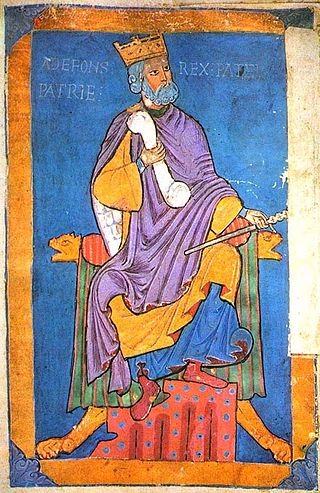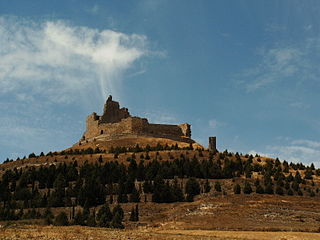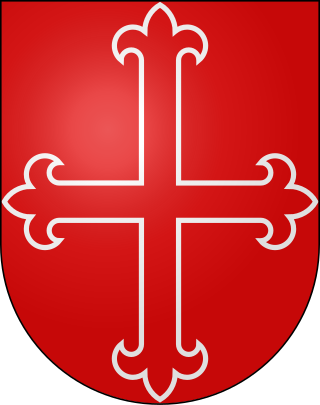
The House of Osorio is an old and influential Spanish noble family, which originated from the Kingdom of Castile.

The House of Osorio is an old and influential Spanish noble family, which originated from the Kingdom of Castile.
They descend from count Osorio Martínez, a prominent nobleman in the first half of the 12th century who was member of the Flagínez family and husband to a granddaughter of king Alfonso VI of León. It was from his grandson, Osorio González, that the family derived its patronymic surname. His son Rodrigo Osorio is relatively obscure, but had two sons who accompanying king Ferdinand III of Castile on his conquest of Seville, receiving lands there, and who used Osorio as a surname: Rodrigo Rodríguez Osorio and Álvar Rodríguez Osorio. The son of Rodrigo Rodríguez, also named Álvar Rodríguez Osorio, rose to prominence in the service of king Sancho IV of Castile. He had three sons, Juan Álvarez Osorio, a court official and ancestor of the later noble family, Gonzalo Osorio, Bishop of Mondoñedo (d. 1326), and Álvar Núñez Osorio, Count of Trastámara, Lemos and Sarria, and mayordomo mayor before being executed by king Alfonso XI in 1329. Later descendants would be Grandees of Spain and would hold numerous titles, including Marquess of Astorga and Duke of Alburquerque. The Osorio shield is gold with two wolves. [1]

Alfonso VI, nicknamed the Brave or the Valiant, was king of León (1065–1109), Galicia (1071–1109), and Castile (1072–1109).

Alfonso IX was King of León from the death of his father Ferdinand II in 1188 until his own death.
Rodrigo Díaz de los Cameros was a Castilian magnate and one of the earliest Galician-Portuguese troubadours. He was the son of Diego Ximénez of La Rioja, the lord of Cameros, and Guiomar Rodríguez. He attained the highest noble rank (count), like his maternal grandparents, Rodrigo Pérez de Traba and Fronilde Fernández.

Gómez González, called de Lara or de Candespina, was a Castilian nobleman and military leader who had some claim to being Count of Castile. He was the eldest son and successor of Gonzalo Salvadórez and his wife Sancha, and thus kinsman of the Lara family. Like his father, he perished in battle.

Osorio Martínez was a magnate from the Province of León in the Empire of Alfonso VII. He served as the emperor militarily throughout his long career, which peaked in 1138–41. Besides the documentary sources, which are somewhat meagre at times after his fall from royal favour, he is mentioned in two episodes in the Chronica Adefonsi imperatoris. He supported Ferdinand II of León after Alfonso's death (1157), but he died in a Castilian civil war in 1160.
The Treaty of Sahagún ended a state of war between the Castile and León, establishing pacem et ueram amiciciam between their respective monarchs, Sancho III and Ferdinand II, who called themselves boni fratres et boni amici. It was signed at the monastery of Sahagún on 23 May 1158.

Agoncillo is a town and municipality in La Rioja province in northern Spain.
Stephanie Alfonso of Castile was an illegitimate daughter of Alfonso VII of León and Castile and Urraca Fernández de Castro, widow of Count Rodrigo Martínez, who was Urraca's cousin or uncle. Her murder by her husband, Fernando Rodríguez de Castro, earned her the sobriquet Stephanie the Unfortunate.

The County of Trastámara was a tenancy of the crown in the Kingdom of Galicia in the Middle Ages. Its name comes from the Latin tra(n)s Tamar(is), meaning "beyond [north of] the Tambre", a river which runs through Galicia. It was regularly granted to men of a single family, the House of Traba from the 11th century into the 13th, after which it was often given for life to others, including Alvar Núñez Osorio and the future King Henry II of Castile, whose dynasty is thus known as the House of Trastámara. On 4 February 1445 in San Martín de Valdeiglesias, it was granted as a hereditary possession to Pedro Álvarez Osorio by Juan II of Castile.

Gonzalo Ruiz Girón was a Spanish nobleman from Palencia. He was Grand Master of the Order of Santiago, and Adelantado of the Kingdom of Murcia. Ruiz was killed at the Battle of Moclín. He was a member of the House of Girón.

Álvaro Núñez de Lara was a Castilian nobleman who played a key role, along with other members of the House of Lara, in the political and military affairs of the Kingdoms of León and Castile around the turn of the 13th century. He was made a count in 1214, served as alférez to King Alfonso VIII of Castile, was the regent during the minority of King Henry I of Castile, and was mayordomo (steward) to King Alfonso IX of León. He opposed Queen Berengaria of Castile and her son King Ferdinand III and supported the King of León during the war between the two countries of 1217–1218. At the end of his life he was a knight of the Order of Santiago, in whose Monastery of Uclés he was buried.

Rodrigo Gutiérrez Girón was a magnate and ricohombre from Palencia who played a key role in the Medieval history of the Iberian Peninsula. He was the first one of his lineage to add Girón to his patronymic. Owner of vast holdings and estates, Rodrigo and his relatives formed one of the most powerful clans in Tierra de Campos since the time of the Banu Gómez.
Rodrigo Muñoz de Guzmán or Rodrigo Núñez de Guzmán, considered the common ancestor of the noble house of Guzmán, was a Castilian magnate and tenente of Roa and of the village of Guzmán in Burgos, from which this lineage took its name.

Rodrigo Fernández de Castro, called the Bald, was a Castilian nobleman and soldier. One of the founders of the House of Castro, he was the second son of Fernando García de Hita and Tegridia, sister or aunt of Count Rodrigo Martínez and relative of the Ansúrez family. His paternal grandfather may have been García Ordóñez, who died at the battle of Uclés in 1108.

Gutierre Fernández de Castro was a nobleman and military commander from the Kingdom of Castile. His career in royal service corresponds exactly with the reigns of Alfonso VII (1126–57) and his son Sancho III (1157–58). He served Alfonso as a courtier after 1134 and as majordomo (1135–38). He was the guardian and tutor the young Sancho III from 1145. Before his death he was also briefly the guardian of Sancho's infant son, Alfonso VIII.

Gutierre Rodríguez de Castro also known as Gutierre Ruiz de Castro and nicknamed el Escalabrado was a Castilian nobleman, member of the House of Castro as the son of Rodrigo Fernández de Castro and his wife Elo Álvarez, daughter of Álvar Fáñez and his wife Mayor Pérez, daughter of Count Pedro Ansúrez.
The Banu Gómez were a powerful but fractious noble family living on the Castilian marches of the Kingdom of León from the 10th to the 12th centuries. They rose to prominence in the 10th century as counts in Saldaña, Carrión and Liébana, and reached their apogee when, allied with Córdoba warlord, Almanzor, their head, García Gómez, expelled king Vermudo II of León and briefly ruled there. He would reconcile with the royal family, but launched two subsequent rebellions. On his death, the senior line of the family was eclipsed, but a younger branch would return to prominence, producing Pedro Ansúrez, one of the premier noblemen under king Alfonso VI and queen Urraca in the late 11th and early 12th centuries. The family would be portrayed in the Cantar de Mio Cid as rivals and antagonists of the hero, El Cid, and their rebellions would serve as a basis for the legend of Bernardo del Carpio.

Jimena Muñoz or Muñiz was a noblewoman from the El Bierzo region of the medieval Kingdom of León, and the mistress of king Alfonso VI of León and Castile during the late 1070s and early 1080s. By him she was mother of two countesses and grandmother of Afonso I, first king of Portugal.

The House of Guzmán is an old and noble Spanish family that emerged in Castile in the 12th century and became one of the most prominent dynasties of the Spanish kingdom until the 18th century. The original family gave rise to several branches, one of which became Dukes of Medina Sidonia from the 15th century to the 18th century, in turn giving rise to other branches including the Count-Dukes of Olivares.

Diego López de Medrano y Hurtado de Mendoza was a noble from the House of Medrano in La Rioja during the successive reigns of John I of Castile, Henry III of Castile and John II of Castile. Diego was a royal ambassador, lawyer and Lord of Agoncillo, Velilla and San Martín de Berberana in the Kingdom of Castile and León.